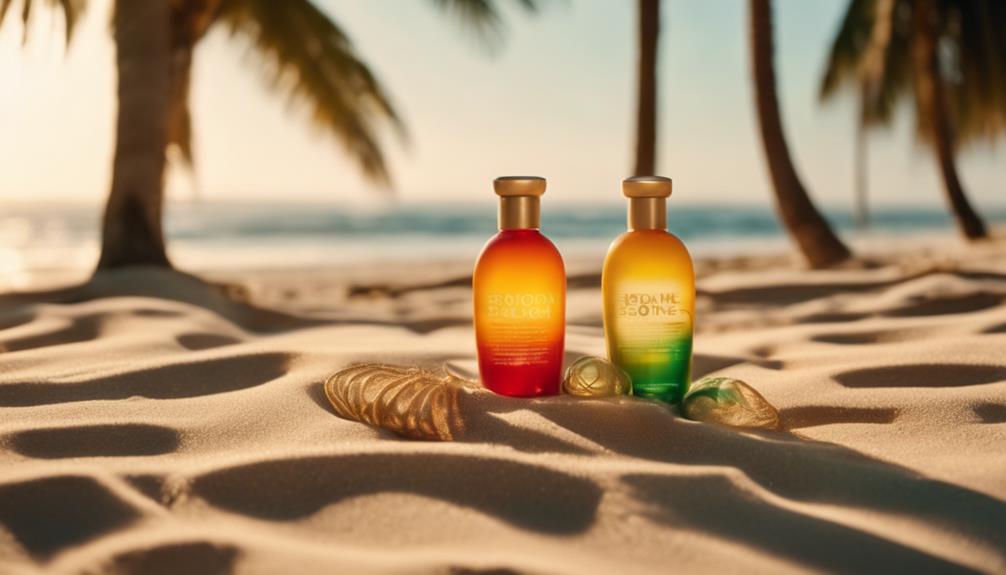To protect yourself from germs in tanning beds, choose reputable salons that prioritize hygiene. Make sure tanning beds are disinfected after each use and follow visible cleaning protocols. Use protective barriers like disposable covers and fresh towels to minimize skin contact with germs. Applying antibacterial lotion before tanning will add an extra layer of protection while keeping your skin hydrated. It is also crucial to wear protective eyewear to shield your eyes from harmful UV exposure. By adhering to these guidelines, you can improve your tanning experience. Discover more tips on maintaining skin health and safety during tanning sessions.
Key Takeaways
- Always choose reputable tanning salons that prioritize cleanliness and have visible cleaning protocols in place.
- Use disposable covers on tanning beds to minimize skin contact with potential germs.
- Apply antibacterial lotion before tanning to protect skin and reduce germ exposure.
- Wear protective eyewear to shield your eyes from harmful UV rays during tanning sessions.
Importance of Cleanliness
Cleanliness is paramount in tanning salons, as a hygienic environment greatly reduces the risk of bacterial exposure and enhances the overall safety of the tanning experience. A meticulous approach to cleanliness not only protects clients from potential infections but also fosters trust in the facility's commitment to health standards.
Clients should observe the salon for signs of cleanliness, such as well-maintained equipment and visible cleaning protocols. Additionally, it is essential to inquire about the disinfecting methods employed and the frequency of bed sterilization. Regular inspections and adherence to established hygiene practices indicate a salon's dedication to maintaining a safe environment.
Ultimately, a clean tanning salon markedly improves client satisfaction and promotes a responsible tanning culture.
Tanning Salon Hygiene Standards
A thorough understanding of hygiene standards in tanning salons is essential for ensuring a safe and healthy tanning experience for all clients. Salons should maintain rigorous cleanliness protocols to prevent the spread of germs and bacteria. Clients should prioritize salons that demonstrate a commitment to hygiene through transparent practices and regular audits.
- Regular Disinfection: Tanning beds must be disinfected after each use to eliminate any potential contaminants.
- Staff Training: Employees should be well-trained in sanitation protocols and adhere to established hygiene standards.
Protective Barriers for Safety

Utilizing protective barriers, such as disposable covers and specialized eyewear, is essential for minimizing germ exposure and ensuring a safe tanning experience. These measures create a crucial line of defense against bacteria that may linger on tanning beds. Always opt for fresh covers or towels and consider using disposable mats for added protection. Additionally, protective eyewear not only shields your eyes from harmful UV radiation but also promotes overall eye health during tanning sessions.
| Barrier Type | Benefits | Emotional Impact |
|---|---|---|
| Disposable Covers | Prevent skin contact with germs | Peace of mind |
| Protective Eyewear | Shields eyes from UV rays | Confidence in safety |
| Fresh Towels | Maintains cleanliness | Comfort in hygiene |
| Disposable Mats | Minimizes germ exposure | Assurance of protection |
| Routine Use | Consistent safety | Trust in tanning experience |
Antibacterial Products for Skin
Incorporating antibacterial products into your tanning routine is essential for safeguarding your skin against potential germs and enhancing overall skin health.
Antibacterial lotions create a protective barrier that not only helps to prevent bacterial growth but also hydrates the skin, ensuring peak condition during tanning sessions. Regular application of these products can greatly reduce the risk of skin irritations commonly associated with tanning bed use.
- Pre-tanning application: Use antibacterial lotion before tanning to shield against germs.
- Hydration benefits: Many antibacterial lotions offer added moisture, promoting skin elasticity and health.
Recommended Tanning Lotions

Selecting the right tanning lotion is essential for achieving a deep, long-lasting glow while also maintaining skin health. Quality lotions not only enhance the tanning process but also protect the skin from potential irritants and bacteria. It is advisable to choose products rich in moisturizers and antioxidants to nourish the skin. The following table outlines some recommended tanning lotions based on their key benefits:
| Lotion Name | Benefits | Suitable Skin Type |
|---|---|---|
| Tan Extender | Prolongs tan, adds hydration | All skin types |
| Brilliance Bronzer | Instant color, deepens tan | Normal to dry skin |
| Antibacterial Blend | Protects against germs, hydrates | Sensitive skin |
| Moisturizing Formula | Nourishes skin post-tan | All skin types |
Health Risks of Tanning Beds
While choosing quality tanning lotions can enhance the tanning experience, it is important to acknowledge the health risks associated with tanning bed use, which include increased chances of skin cancer and other adverse effects.
Research indicates that the exposure to UV radiation from tanning beds considerably elevates the risk of developing melanoma and other skin cancers. Additionally, tanning beds can lead to premature aging and skin damage, impacting overall skin health.
- Increased risk of melanoma, particularly in younger individuals.
- Potential eye damage from UV exposure, leading to conditions like cataracts.
Awareness of these risks is essential for anyone considering the use of tanning beds.
Safe Tanning Practices

To guarantee a safe tanning experience, it is essential to adopt a combination of protective measures, hygiene practices, and appropriate skincare routines.
Begin by choosing a reputable tanning salon that maintains high cleanliness standards, including regular disinfection of tanning beds. Always use protective barriers, such as fresh towels or disposable covers, to minimize direct contact with surfaces.
Protective eyewear is vital to shield your eyes from harmful UV radiation. Additionally, incorporating antibacterial lotions into your routine can help create a barrier against germs while keeping your skin hydrated.
Before and after tanning, confirm proper skincare to maintain skin health. By implementing these practices, you can enjoy a safer tanning experience while mitigating the risks associated with tanning beds.
Are Tanning Beds a Safe Option to Shield Yourself From Germs?
Tanning beds are not a safe option for mastering safe tanning techniques and shielding yourself from germs. The intense UV radiation can damage your skin, increasing your risk of skin cancer. It’s better to use safer alternatives such as self-tanners or spray tans to achieve a sun-kissed look.
Conclusion
In the domain of sunless tanning, vigilance emerges as the guardian against lurking pathogens.
By embracing stringent hygiene practices, utilizing protective barriers, and selecting quality products, a radiant glow can be achieved without compromising health.
The balance between beauty and safety is paramount, illuminating the path toward a responsible tanning experience.
Ultimately, awareness and proactive measures transform a simple quest for bronze into a shielded journey, safeguarding skin and spirit from the shadows of potential harm.










